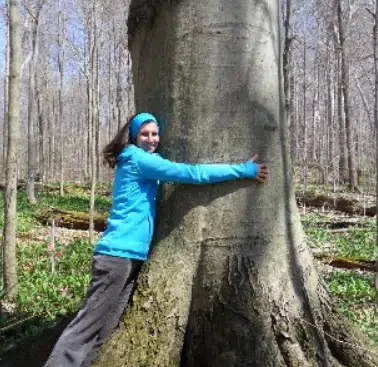
It should come as no surprise that trees are very reliant on the soil they grow in. A tree’s growth and health are deeply rooted in the soil (pun intended), but the relationship between tree growth and soil can be complex. It is not always clear why certain changes to the soil result in changes to tree growth.
This summer, like every summer for the past 12 years, David Burke’s lab has been busy measuring diameter at breast height (DBH) on over 1500 mature trees. DBH can be calculated by measuring the circumference of a tree trunk at 4.5 feet from the ground and converting it to diameter. Thankfully for those of us who measure many trees each year, specially calibrated diameter tapes can be purchased that automatically estimate the diameter of a cylinder object, such as a tree trunk.
The 1500 trees are located within Holden’s natural areas and in the forest at CWRU’s University Farm and have been monitored for growth since 2009. At that time, soils in some plots of these forests were manipulated to raise pH or phosphorus availability. The response of mature trees to these manipulations can be slow. We now have 12 years of data, and we can start to make conclusions about how the soil treatments affected tree growth.
Preliminary data suggest that phosphorus additions decreased growth of some tree species, including American beech. We know that American beech trees are currently experiencing Beech Leaf Disease that can also affect their growth. However, our result of decreased tree growth with phosphorus addition was consistent over the entire length of the study and dated back to 2010. Beech Leaf Disease was first noticed in Lake County in 2012 and not found at Holden Arboretum until 2014 (Burke et al., 2020). Thus, the decreased growth of American beech with phosphorus treatment pre-dates Beech Leaf Disease. In addition, there were no visible changes to the yearly growth of the beech trees after Beech Leaf Disease emerged, which suggests that the growth decrease with phosphorus addition is unrelated to the disease. At first, our result of decreased growth was counterintuitive to us. Since phosphorus is a much-needed nutrient for plants, we would expect phosphorus additions to increase tree growth and we found the opposite. However, we have a hypothesis for what we think is going on!
We think the addition of phosphorus lead to the trees no longer supporting their mycorrhizal fungi. Mycorrhizal fungi are known to acquire essential nutrients for their plant hosts, including nitrogen and phosphorus. Due to the elevated phosphorus treatment raised phosphorus availability, it is likely that the trees no longer needed their mycorrhizae to access phosphorus. While the loss of their mycorrhizal partners may have not impaired the ability of trees to acquire phosphorus in the elevated phosphorus treatment, it may have impacted their ability to access other nutrients (e.g., nitrogen), leading to decreased growth overall. We look forward to testing this hypothesis in the years to come! In the meantime, we will enjoy another year of hiking through beautiful forests on summer days to measure DBH and continue our long-term monitoring of the over 1500 trees!
Acknowledgments
We thank many Research Department summer interns and countless volunteers, including the Research Renegades, for their help in continuing this data set. We could not have managed to collect DBH measurements every year without their invaluable help!
Reference
Burke, D.J.; Hoke, A.J.; Koch J. 2020. The emergence of beech leaf disease in Ohio: Probing the plant microbiome in search of the cause. Forest Pathology 50:e12579.



Sarah Kyker
Postdoctoral Research Associate











